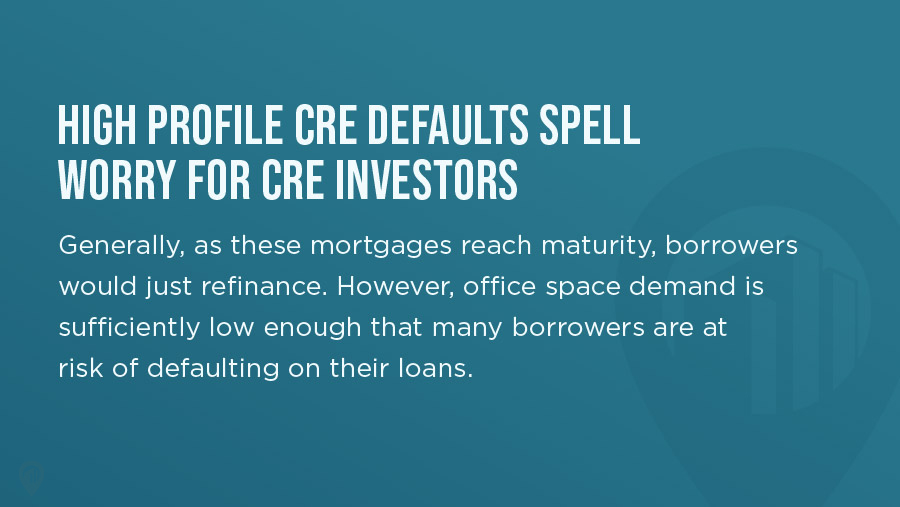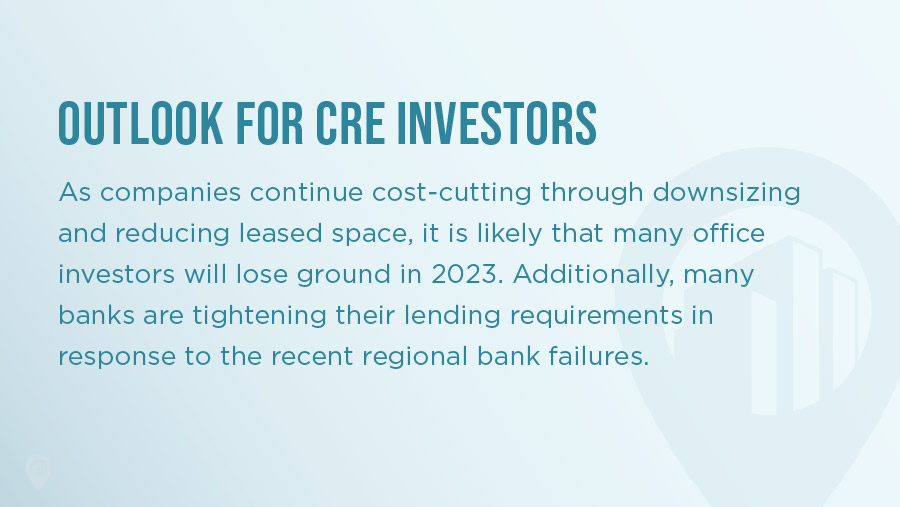Is a Loan Maturity Crisis on the Horizon for CRE in 2023?

Specializes in providing actionable insights into the commercial real estate space for investors, brokers, lessors, and lessees. He covers quarterly market data reports, investment strategies, how-to guides, and top-down perspectives on market movements.

The collapses of Silicon Valley Bank and Signature Bank have undoubtedly highlighted the important role commercial banks play in commercial real estate lending.
Although tensions from SVB and Signature’s collapse have started to die down, many commercial real estate experts believe we are on the cusp of another real estate crisis.
According to data from Trepp, there are over $217 billion of current securitized commercial real estate mortgages in the US alone. About $32 billion of those loans (15%) will reach maturity next year—with up to $12.3 billion worth of office space loans. Further, a total of $500 billion in loans are set to reach maturity by 2027.
As these loans reach maturity, many experts worry that relatively low commercial real estate demand could result in several defaults and foreclosures. As regional banks lend a large proportion of commercial real estate, they risk being hit the hardest by any crisis.
High Profile CRE Defaults Spell Worry for CRE Investors

Generally, as these mortgages reach maturity, borrowers would just refinance. However, office space demand is sufficiently low enough that many borrowers are at risk of defaulting on their loans.
These worries have been backed by a recent string of high-profile defaults on office buildings around the country in the past 12 months. For example, Columbia Property Trust defaulted on over $1.7 billion backing seven buildings in major cities across the country, while Columbia’s parent company Pimco defaulted on its 846,000 square-foot Class-B property in Dallas.
In Los Angeles, Brookfield Asset Management defaulted on a $750 million loan for an office at 777 South Figueroa St, while both Bentall Green Oak and Related Cos. lost two of their properties in Long Island.
The History of Current CRE Debt Maturities
The current CRE debt maturity situation can be traced back to the aftermath of the 2008 Recession. After the 2008 subprime mortgage crisis, the Federal Reserve lowered interest rates from 4.5% to 2.0% in order to restimulate economic growth. The low interest rates made money relatively cheap to borrow and resulted in a proliferation of CRE loans issued between 2010 and 2020.
The COVID-19 Pandemic and the 2008 Housing Crisis
However, interest rates have nearly doubled since 2008 on the back of interest rate hikes from the Federal Reserve, meaning that debt coverage ratios have risen. Because rates are so high, current lenders can’t provide loan amounts high enough to refinance old loans.
These shaky fundamentals were also significantly exacerbated by the COVID-19 pandemic as commercial real estate demand plummeted. Gathering restrictions, mask requirements, and business closures have had an enormously negative effect on retail, hospitality, and office space rents and occupancy rates.
The two most recent bank collapses have only further reinforced the problem. Although not a full-blown crisis, the SVB and Signature Bank collapses have put stress on other regional banks that may reduce lending levels.
CRE Loan Maturity and the Office Space Sector
The commercial property type that may be affected most by current maturity rate trends is office space. The office space real estate market underwent a complete transformation due to decreased demand from remote and hybrid work schedules.
According to data from Trepp, over $40 billion in office space loans are expected to mature by 2025, representing over 350 loans and 583 office properties across the country. The average square footage of these leases is 38,500 square feet, and over half the loans have floating interest rates.
Rising Debt-Service Costs
Loans that might be of immediate importance include the $6 billion of office space loans maturing in 2023. These loans may come to maturity at the height of the Federal Reserve’s interest rate hikes, meaning that debt-service costs for refinancing these loans could increase between 40% and 60%. Many of these loans have extension options, but it is unclear how many tenants will take that option.
The unfortunate result of these near-term loan maturities is that many could have serious problems refinancing. Given that many owners are projecting decreasing rents due to low office space demand, even presumably healthy loans can quickly turn after a significant interest rate hike.
What Is the Maturity Outlook for 2023 and Beyond?
As more and more loans come to maturity in the next half-decade, many experts believe that capital markets will remain problematic in the near term. While not exactly a crisis, loan maturities could be a preamble to recession.
“With a large trough of loans coming due between now and 2027 across all lender platforms, and an uncertainty about where interest rates will level off and—if ever—returning to such low levels of the past decade, maturing loans will continue to be problematic,” iBorrow’s CEO Brian Good told ConnectCRE.
However, the odds of a full-blown crisis in any particular year are uncertain. According to recent data, upcoming maturities are fairly consistent from 2023 to 2026, meaning that no particular year will bear all the stress. Given consistent maturity levels, there is no “wall” of maturity that investors will hit.
Outlook for CRE Investors

As companies continue cost-cutting through downsizing and reducing leased space, it is likely that many office investors will lose ground in 2023. Additionally, many banks are tightening their lending requirements in response to the recent regional bank failures. Depending on interest rates, investors with loans maturing in the next two years may have difficulties with refinancing options.
The silver line on the investor side is that effective rental rates still continue to rise, even though landlords will have to make concessions to tenants. Specifically, the majority of effective rental growth has been in properties built in the past ten years, creating a noticeable division in the market between new, Class A properties with growing effective rents and Class B and lower properties with essentially flatlining rents.
Find & Connect With Commercial Real Estate Agents & Brokers for Free on MyEListing.com
MyEListing.com maintains one of the largest commercial agent directories in the country. Use it for free to find an agent or broker near you.
Article Search
Share
All Article Categories








